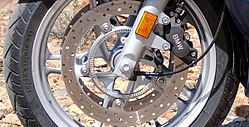Motorcycle components
The topic of this articlemay not meet Wikipedia'sgeneral notability guideline.(July 2021) |
Motorcycle componentsand systems for amotorcycleare engineered, manufactured, and assembled in order to produce motorcycle models with the desired performance, aesthetics, and cost. The key components of modern motorcycles are presented below.
Chassis
[edit]The chassis of a motorcycle includes the frame and suspension, along with the front forks, of the vehicle.[1]
Frame
[edit]The frame is typically made from weldedaluminiumorsteel(oralloy) struts, with the rearsuspensionbeing an integral component in the design.Carbon fibre,titanium,andmagnesiumare used in a few very expensive custom frames.
The frame includes thehead tubethat holds thefront forkand allows it to pivot. Some motorcycles include the engine as a load-bearingstressed member;this has been used all through motorcycle history but is now becoming more common.
Oil-in-frame (Oif) chassis, where the lubricating oil is stored in the frame of the motorcycle, was used forVincent Motorcyclesof the 1950s, and for a while during the 1970s on someNVTBritish motorcycles. It was widely unpopular and generally regarded as a bad idea at the time. Today it is a used on some "thumpers"(single-cylinder four-strokes) that usually have dry-sump lubrication requiring an external oil tank. It has since gained some cachet in the modern custom bike world too because of the space savings it can afford and the reference to an earlier era.[2]
Buellmotorcycles employed a similar design with the oil held in theswingarmand fuel held in the frame.
Suspension
[edit]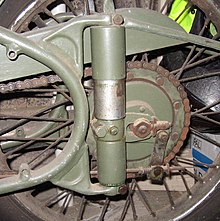
Modern designs have the two wheels of a motorcycle connected to the chassis by a suspension arrangement, however 'chopper' style motorcycles often elect to forgo rear suspension, using a rigid frame.
The front suspension is usually built into thefront forkand may consist of telescoping tubes calledfork tubeswhich contain the suspension inside or some multibar linkage that incorporate the suspension externally. There is another type of front suspension system which is Earles type which highly used in off-road motorcycles.[3]
The rear suspension supports theswingarm,which is attached via theswingarm pivot boltto the frame and holds theaxleof the rear wheel. The rear suspension can consist of several shock arrangements:
- Dual shocks, which are placed at the far ends of the swingarm
- Traditional monoshock, which is placed at the front of the swingarm, above the swingarm pivot bolt
- Softailstyle suspension, where the shock absorbers are mounted horizontally in front of the swingarm, below the swingarm pivot bolt and operate in extension.
Fuel tank
[edit]A fuel tank (also called a petrol tank or gas tank) is a safe container for flammable fluids. Though any storage tank for fuel may be so called, the term is typically applied to part of an engine system in which the fuel is stored and propelled (fuel pump) or released (pressurized gas) into an engine.
Front fork
[edit]A motorcycle fork is the portion of a motorcycle that holds the front wheel and allows one to steer. For handling, the front fork is the most critical part of a motorcycle. The combination ofrake and traildetermines howstablethe motorcycle is.
The 'fork' on a motorcycle consists of multiple components. The triple trees (also known as yokes) hold the fork tubes (which contain the fork springs), and are fastened to the neck of the frame by the steering stem. At the bottom of the fork tubes are the lower legs, often referred to as sliders. The sliders house the dampening assemblies, which vary based on the brand and type of fork. The front axle is located perpendicular and engages the sliders.[4]Thehandlebarsare clamped to the top triple tree and allow the rider to steer the motorcycle.
Engine
[edit]
Almost all commercially available motorcycles are driven by conventional gasolineinternal combustion engines,but some small scooter-type models use anelectric motor,and a very small number ofdieselmodels exist (e.g., theUSMCM1030 M1 version of theKawasaki KLR650and the Dutch-produced Track T-800CDI).
Motorcycle engines range from less than 50 cc (cubic centimetres), commonly found in many small scooters, to 5735 cc, a ChevroletV8 engine,currently used by Boss Hoss in its cruiser style motorcycle.
Motorcycles have mostly, but not exclusively, been produced with one to fourcylinders,and designers have tried virtually every imaginable layout. The most common engine configurations today are thesingleandtwin,theV-twin,theopposed twin(orboxer), and thein-line tripleandin-line four.A number of others designs have reached mass production, including theV-4,theflat 6-cylinder,theflat 4-cylinder,thein-line 6-cylinder,and theWankel engine.Exotic engines, such as aradial pistonengine, sometimes appear in custom built motorcycles, though two firmsMegolaand Redrup put radial-engined motorcycles into production.

Engines with more cylinders for the same displacement feel smoother to ride. Engines with fewer cylinders are cheaper, lighter, and easier to maintain. Liquid-cooled motorcycles have aradiatorwhich is the primary way their heat is dispersed. Coolant or oil is constantly circulated between this radiator and the cylinder when the engine is running. Air-cooled motorcycles rely on air blowing past fins on the piston cylinder head and/or engine case to disperse heat. Liquid-cooled motorcycles have the potential for greater power at a given displacement, tighter tolerances, and longer operating life, whereas air-cooled motorcycles are potentially cheaper to purchase, less mechanically complex and are lighter.
An air-cooled engine contracts and expands with its wider temperature range, requiring looser tolerances, and giving shorter engine life. The temperature range of an air-cooled two-stroke is even more extreme and component life even shorter than in an air-cooled four-stroke.
As applied to motorcycles,two-stroke engineshave some advantages over equivalentfour-stroke engines:they are lighter, mechanically much simpler, and produce more power when operating at the high rpm power-band. But four-stroke engines are cleaner, more reliable, and deliver power over a much broader range of engine speeds. In developed countries, two-stroke road-bikes are rare, because—in addition to the reasons above—modifying them to meet contemporary emissions standards is prohibitively expensive. Almost all modern two-strokes are single-cylinder, liquid-cooled, and under 600 cc.
In November 2006, theDutchcompany E.V.A. Products BV Holland announced that itsdiesel motorcycle,the Track T-800CDI, achieved production status.[5] The Track T-800CDI uses an 800 cc three-cylinder Daimler Chrysler diesel engine. Other manufacturers, includingRoyal Enfield,had been producing diesel-powered bikes since at least the 1980s.[6] Also, Intelligent Energy, an English alternative-fuel company, is developing a motorcycle powered by a detachablehydrogen-poweredfuel cell,which it calls an Emissions Neutral Vehicle (ENV).[7] According to reports, the vehicle can sustain speeds of 80 km/h while making virtually no noise, and can run for up to four hours without refuelling.
Transmission
[edit]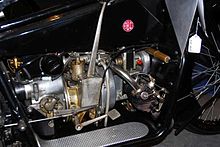
Most motorcycles have asequential manual transmissionshifted by a foot lever. Some (mostly smaller) motorcycles, and manyscootersuse either acontinuously variable transmission,or ahydraulic automatic transmission.semi-automatic transmissionsare also in use; where the driver's input is still required for shifting gears, but the clutch system is controlled and operated automatically. These systems are mostly found on smaller dirt bikes (e.g.,minibikes;such aspit bikes),underbones,many oldermopedsand scooters, and various other types of motorcycles.
Engine power can be engaged or interrupted through theclutch,typically an arrangement of plates stacked in alternating fashion, one geared on the inside to the engine and the next geared on the outside to the transmission input shaft.
Final drive
[edit]
Power transfer from the gearbox to the rear wheel is accomplished by different methods.
Chain-driveusessprocketsand aroller chain,which requires both lubrication and adjustment for elongation (stretch) that occurs through wear. The lubricant is subject to being thrown off the fast-moving chain and results in grime and dirt build-up. Chains do deteriorate, and excessive wear on the front and rear sprockets can be dangerous. In a chain-drive, the power is transmitted into the rear wheel via acush drive.Conventional roller chain-drives suffer the potential for vibration, as the effective radius of action in a chain and sprocket combination constantly changes during the revolution ( "chordal action" ). If a drive sprocket rotates at constant RPM, then the chain (and the driven sprocket) must accelerate and decelerate constantly. Most chain-driven motorcycles are fitted with a rubber bushed rear wheel hub to eliminate this vibration issue.Belt-driveandshaft-driveare also used.
Chain lubrication
[edit]Small budget motorcycles may have a totally enclosed drive chain, but this is rare on larger motorcycles, an exception being theNorton rotary bikes.To prevent rapid wear of the chain and sprockets, it is customary to apply an adhesive petroleum, graphite or silicon based composite chain-lube via an aerosol. Many riders also fit aftermarket chain-oilers to feed a regular supply of oil to the chain at the rear sprocket.[8]These chain oilers vary in sophistication, but all add significantly to the life of the chain. The custom of lubing by immersing the chain in a tin of hot grease ceased in the early 1970s, once most chains had rubber "O'-rings. The originalSuzuki RE5of 1975 came with a rear chain oiler, but the 1976 model had a sealed chain, and itsoiler was deletedas "unnecessary".

Abelt-driveis still subject to stretch but operates very quietly, cleanly, and efficiently. Atoothed beltis frequently used. However, they are not as durable when subjected to high horsepower as a chain. You can not alter the length and change final drive ratios as easily as chains. They also can not wrap as closely around chains. And require larger pulleys compared to chain sprockets to get an effective final drive ratio. Replacing a drive belt typically requires removal of the swingarm, since belts cannot be split the way a chain with amaster linkcan.
Ashaft-driveis usually completely enclosed; the visual cue is a tube extending from the rear of the transmission to a bell housing on the rear wheel. Inside the bell housing a bevel gear on the shaft mates with another on the wheel mount. This arrangement is superior in terms of noise and cleanliness and is virtually maintenance-free, with the exception of occasional fluid changes. They are the most durable and usually last the life of the motorcycle. However, the additional gear sets are a source of power loss and added weight. A shaft-equipped motorcycle may also be susceptible toshaft effect.
Virtually all high-performance racing motorcycles use chain-drive because they are the most mechanically efficient transmitting power to the rear wheel.
Wheels
[edit]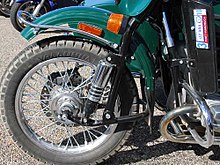
Thewheelrims are usually steel or aluminum (generally with steelspokesand an aluminum hub) ormag-typecastormachinedaluminum. Castmagnesiumdisks, produced by one-step hot forging from magnesiumalloysZK60 and MA-14, are also used for many motorcycle wheels.
At one time, motorcycles usedwire wheelsbuilt up from separate components,but, except fordirtbikes,one-piece wheels are more common now. Performance racing motorcycles often usecarbon-fibrewheels, but the expense of these wheels is prohibitively high for general usage.
Tires
[edit]Motorcycles mainly usepneumatic tires.However, in some cases where punctures are common (someenduros), the tires are filled with atire moussewhich is unpunctureable. Both types of tire come in many configurations. The most important characteristic of any tire is thecontact patch,the small area that is in contact with the road surface while riding. There are tires designed for dirt bikes, touring, sport and cruiser bikes.
Dirt bike tires have knobbly, deep treads for maximum grip on loose dirt, mud, or gravel; such tires tend to be less stable and noisier on paved surfaces.
Sport or performance tires are designed to provide maximum grip for street use on paved surfaces but tend to wear faster.
Touring tires are usually made of a harder rubber compound for greater durability, these may last longer but tend to provide less outright grip compared to sports tires at optimaloperating temperatures.Touring tires typically offer more grip at lower temperatures and can be more suited to riding in cold or winter conditions where a sport tire may never reach its optimal operating temperature.
Cruiser and sport touring tires are designed to compromise between grip and durability. These tend to have stronger sidewalls as they are typically fitted to heavier machines.
Motorsport or racing tires offer the highest of levels of grip. Due to the high temperatures at which these tires typically operate, use outside a racing environment is unsafe, typically these tires do not reach their optimum temperature which provides less than optimal grip. In racing situations, tires are normally brought up to temperature in advance based on application and conditions through the use of tire warmers.
Brakes (disc/drum)
[edit]
There are generally two independentbrakeson a motorcycle, one set on the front wheel and one on the rear. However, some models have "linked brakes" whereby both can be applied at the same time using only one control.
Front brakes are generally much more effective than rear brakes: roughly two thirds of stopping power comes from the front brake—mainly as a result of weight transfer being much more pronounced compared to longer or lower vehicles, because of the motorcycle's shortwheelbaserelative to its center of mass height. This can result inbrake dive.
Brakes can either bedrumordiscbased, with disc brakes being more common on large, modern or more expensive motorcycles for their far superior stopping power, particularly in wet conditions. There are many brake-performance-enhancing aftermarket parts available for most motorcycles, including brake pads of varying compounds and steel-braided brake lines.
Harley-Davidson replaced drum brakes with disc brakes on Big Twin models starting in 1972, and on Sportster models starting in 1973.
In 1981, BMW introduced anantilock braking system(ABS) on a motorcycle. Other manufacturers have since also adopted this technology. ABS is normally found on motorcycles of 500 cc or greater engine capacity, although it is available on motor scooters down to 49 cc.
Instruments
[edit]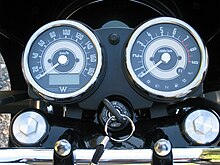
Most road motorcycles have aninstrument panel,usually consisting ofspeedometer,odometerandtachometer.
Fuel gaugesare becoming more common, but traditionally a reserve tank arrangement is used with apetcock(petrol tap) on the side of the motorcycle allowing the rider to switch to areserve fuel supplywhen the main fuel supply is exhausted. There is not actually a separate reserve tank: The intake for the petcock has two pipes, one extending higher into the fuel tank than the other. When fuel no longer covers the longer pipe the engine will lose power/splutter and the rider switches the petcock to the "reserve" setting, which accesses the shorter pipe. Riders whose bikes lack a fuel gauge (most machines prior to the past few years) usually learn how far they can go with a full tank of fuel, and then use a trip meter if available to judge when they must refill the tank.
Lighting system
[edit]This sectionpossibly containsoriginal research.(July 2023) |
There should be no lights and indicators for a race bike or race machine because the bike should be less in weight.
Because of safety and vehicle laws, any motorcycle that's not for racing will have some degree of a lighting system that consists of low and high beam head lamps, brake indication and running lights and turn indicators.Lighting can vary from incandescent filament lamps, gas charged lamps with halogen or argon gas filled bulbs, and in recent years, LED's. The lighting system will always function if the ignition is turned to the ON position. The low and high beam controller and the turn signal controls are usually placed on an easily operated and accessible cluster next to the hand grips. The brake light is engaged when either the front or rear brakes are applied by the use of spring loaded contacts near the front brake lever or the rear brake peddle. The lighting system uses a simple fuse box to separate the systems components and is connected to a battery. Some large touring bikes also incorporate the use of running lights or decorative accessory lights to make them more visible to other drivers at night. Some manufacturers have added a strobe effect to the headlamps to make other drivers more aware of the oncoming motorcycle. A large percentage of motorcycle accidents occur because other drivers don't see motorcycles in traffic.
Ignition key switch
[edit]An ignition switch, starter switch or start switch is aKey switchin the control system of a motor vehicle that activates the main electrical systems for the vehicle.In vehicles powered by internal combustion engines, the switch provides power to the starter solenoid and the ignition system components (including the engine control unit and ignition coil), and is frequently combined with the starter switch which activates the starter motor.
See also
[edit]References
[edit]- ^"Chassis".motorcycle-glossary.Retrieved2007-07-03.
- ^Martin Peacock (3 April 2006)."Oil In Frame Triumphs - A Potted History".The Vintage Motorcycle Club, South Durham Section.Archived fromthe originalon 3 March 2007.Retrieved16 May2007.
- ^"Basic Motorcycle Systems".motorcyclist lifestyle.19 May 2017.
- ^"Harley-Davidson Forks Types and How to Identify Them – Lowbrow Customs".17 July 2023.
- ^"The first commercially-available diesel motorcycle".Gizmag.20 November 2006.Retrieved2007-06-28.
- ^"Diesel motorbikes".Journey to Forever.Retrieved2007-06-28.
- ^Earth Talk (1 July 2007)."How Much Pollution do Motorcycles Generate?".Environment, Health News Digest.Retrieved2007-07-02.
- ^"SV1000 (2003 - 2005) review".
External links
[edit]- How Motorcycles Workby Bill Harris
- Motorcycle Glossary- definitions of motorcycle terms

